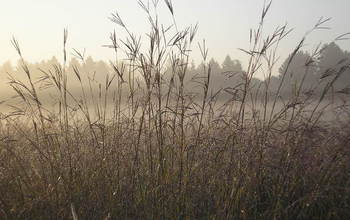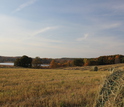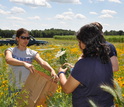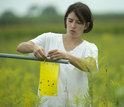News Release 14-007
There's more to biofuel production than yield
Focusing solely on yield comes at a high price

Early morning in a big bluestem-dominated mixed prairie in the U.S. Midwest.
January 13, 2014
This material is available primarily for archival purposes. Telephone numbers or other contact information may be out of date; please see current contact information at media contacts.
When it comes to biofuels, corn leads the all-important category of biomass yield. However, focusing solely on yield comes at a high price, scientists say.
In this week's issue of the journal Proceedings of the National Academy of Sciences (PNAS), the researchers show that looking at the big picture allows other biofuel crops, such as native perennial grasses, to score higher as viable alternatives.
"We believe our findings have major implications for bioenergy research and policy," said Doug Landis, a biologist at Michigan State University (MSU) and one of the paper's lead authors.
"Biomass yield is obviously a key goal, but it appears to come at the expense of many other environmental benefits that society may desire from rural landscapes."
Landis and a team of researchers from the Great Lakes Bioenergy Research Center and the National Science Foundation (NSF) Kellogg Biological Station Long-Term Ecological Research (LTER) site compared three potential biofuel crops: corn, switchgrass and mixes of native prairie grasses and flowering plants.
Kellogg Biological Station is one of 26 such NSF LTER sites in ecosystems from grasslands to coral reefs, deserts to mountains around the world.
"Sustainability, food security, biodiversity, biofuel production--all are important to an increasing human population," says Saran Twombly, program director in NSF's Division of Environmental Biology, which funded the research through the LTER Program. "This is a superb example of how fundamental ecological research can assist human well-being."
The scientists measured the diversity of plants, pests and beneficial insects, birds and microbes that consume methane, a greenhouse gas that contributes to climate change.
Methane consumption, pest suppression, pollination and bird populations were higher in perennial grasslands.
In addition, the team found that the grass crops' ability to harbor such increased biodiversity is strongly linked to the fields' location relative to other habitats.
For example, pest suppression, which is already higher in perennial grass crops, increased by an additional 30 percent when fields were located near other perennial grass habitats.
That suggests that to enhance pest suppression and other critical ecosystem services, coordinated land use should play a key role in agricultural policy and planning, Landis said.
"With supportive policies, we envision the ability to design agricultural landscapes to maximize multiple benefits," he said.
However, rising corn and other commodity prices tempt farmers to till and plant as much of their available land as possible.
"Corn prices are currently attractive to farmers, but with the exception of biomass yield, all other services were greater in the perennial grass crops," Landis said.
"If high commodity prices continue to drive conversion of these marginal lands to annual crop production, it will reduce the flexibility we have in the future to promote other critical services like pollination, pest suppression and reduction of greenhouse gases."
Additional MSU researchers involved in the study include Ben Werling, Timothy Dickson, Rufus Isaacs, Katherine Gross, Carolyn Malmstrom, Leilei Ruan, Philip Robertson, Thomas Schmidt, Tracy Teal and Julianna Wilson.
Scientists from the University of Wisconsin, University of Nebraska, Bard College and Trinity Christian College were part of the research.
The work was also funded by the U.S. Department of Energy and MSU AgBioResearch.
-NSF-
-
Switchgrass harvest for research at NSF's Kellogg Biological Station LTER site in Michigan.
Credit and Larger Version -
Collecting plant biomass samples at the NSF KBS LTER mixed prairie research site.
Credit and Larger Version -
Ecologists empty bee bowls used to sample for pollinators.
Credit and Larger Version -
Field researcher checks insect "sticky traps."
Credit and Larger Version -
Scientists collect insect samples at the KBS LTER site.
Credit and Larger Version
Media Contacts
Cheryl Dybas, NSF, (703) 292-7734, email: cdybas@nsf.gov
Layne Cameron, MSU, (517) 353-8819, email: layne.cameron@cabs.msu.edu
Related Websites
NSF Kellogg Biological Station LTER Site: http://lter.kbs.msu.edu/
The KBS LTER Project: Long-term Ecological Research in Row-crop Agriculture: http://www.nsf.gov/awardsearch/showAward?AWD_ID=1027253&HistoricalAwards=false
NSF LTER Network: http://www.lternet.edu
Landscape Change Leads to Increased Insecticide Use in U.S. Midwest: http://www.nsf.gov/news/news_summ.jsp?cntn_id=120928
Scientists Develop New Carbon Accounting Method to Reduce Farmers' Use of Nitrogen Fertilizer: http://www.nsf.gov/news/news_summ.jsp?cntn_id=123848
The U.S. National Science Foundation propels the nation forward by advancing fundamental research in all fields of science and engineering. NSF supports research and people by providing facilities, instruments and funding to support their ingenuity and sustain the U.S. as a global leader in research and innovation. With a fiscal year 2023 budget of $9.5 billion, NSF funds reach all 50 states through grants to nearly 2,000 colleges, universities and institutions. Each year, NSF receives more than 40,000 competitive proposals and makes about 11,000 new awards. Those awards include support for cooperative research with industry, Arctic and Antarctic research and operations, and U.S. participation in international scientific efforts.
Connect with us online
NSF website: nsf.gov
NSF News: nsf.gov/news
For News Media: nsf.gov/news/newsroom
Statistics: nsf.gov/statistics/
Awards database: nsf.gov/awardsearch/
Follow us on social
Twitter: twitter.com/NSF
Facebook: facebook.com/US.NSF
Instagram: instagram.com/nsfgov







